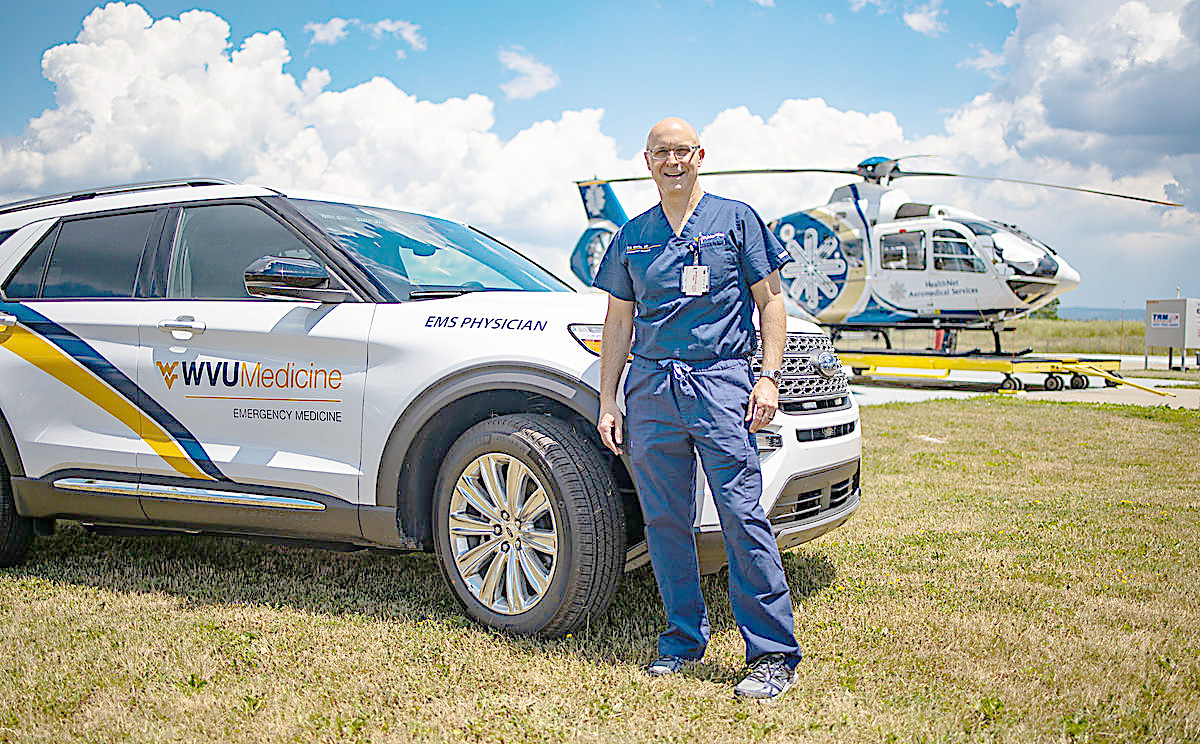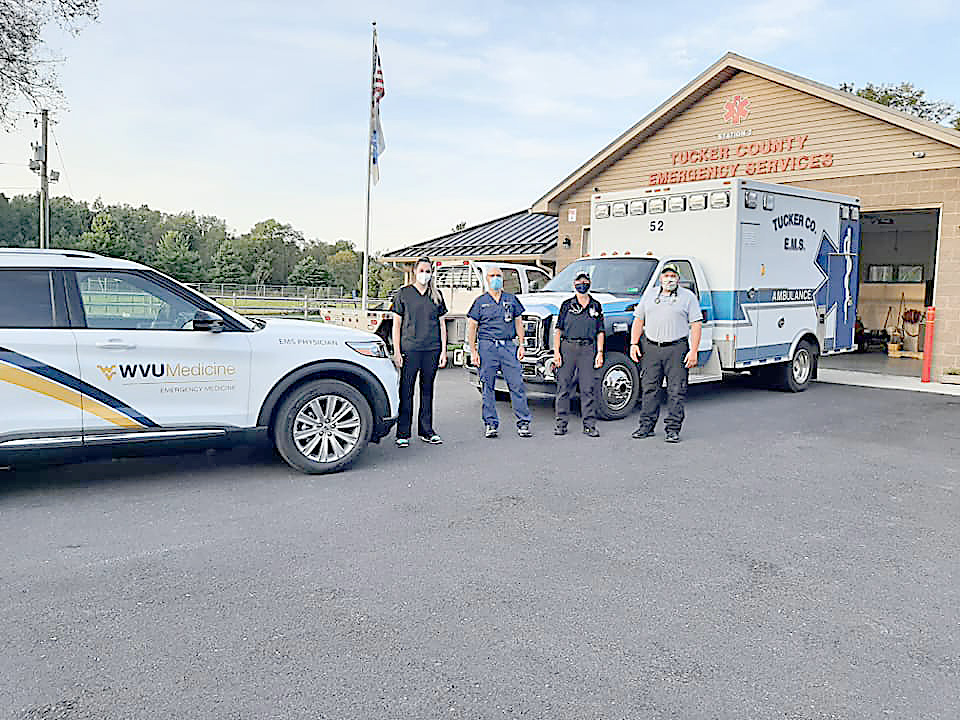
By Heather Clower
The Parsons Advocate
Tucker County native Dr. P.S. Martin, graduate with the class of 1984, is fulfilling a dream of giving back to his county in a big way. Serving as the Director of Pre-Hospital Medicine at West Virginia University with the Department of Emergency Medicine, he has spearheaded a pilot project which brings physicians into the fields to serve on 911 calls alongside the local first responders. He explained, “In 2014, EMS became its subspecialty board certification for a physician.” This allowed for a medical doctor to specialize in the field of emergency medical specialties, similar to a doctor specializing in cardiology, dermatology, or other areas of interest. “The test has only been given three times,” Martin stated, “I was actually the first, I just came back to W.Va. practicing four years ago.” When he returned to W.Va. after working in Pittsburg, Pa. for 19 years, Martin was the only EMS board-certified physician to offer the EMS board certification program through WVU.
With applications and accreditation in place, the new program is set to begin in July of 2021 with the potential of educating two physicians per year. “This is for physicians who have finished their medical school and also finished their residency training in emergency medicine to go on to specialize specifically in EMS or pre-hospital care,” Martin said. “It also trains them to be medical directors and more involved medical directors, and also in addition to that to do pre-hospital research.”
Part of the program for the physicians, known as fellows, is to train them to work in the field alongside the EMS workers, not to replace EMS, but to “augment what EMS does and to help EMS to do their job by working beside them,” Martin said. “We will bring quite a few skills, quite a few additional things to them, but to do that I had to have a mechanism to get our physicians out into the field,” which is where the EMS Physician Response program comes into play.
Martin applied for and received a $300,000 grant from DTE Energy to begin this program within W.Va. Though challenges were working with the re-written EMS Acts, which did not include physicians having a role working in the field. The EMS agreed to work with the pilot project as long as the county’s EMS medical director agreed to accept full responsibility for the program. “I am currently the Medical Director in Tucker County and also the Medical Director in Marion County,” Martin said, both of which contain a significant amount of rural areas, which is his main focus.
Part of the requirements of instilling a new program at WVU included recruiting additional board-certified physicians to serve as faculty. There are currently three faculty members, though by the time the program begins on July 1 there will be a fourth. The faculty will be in charge of educating two fellows per year within the program.
Since the pilot project kicked off within the last two months, Martin was the only board-certified physician eligible to be responding to calls in the physician vehicle. “By the time we start this program, there will be six physicians able to go out on our response vehicles, and there will be two response vehicles,” Martin explained. There will be a schedule set for the county that the attending physician and potentially an emergency medical resident and/or student will be on the vehicle. When calls are not coming in, the physicians will be working with EMS providing training and educational opportunities.
Once the fellowship begins in July, the number of days the physician response vehicle will be available throughout the county will dramatically increase. “My goal with this program is, there are quite a few EMS fellowships across the country now, but very few of them focus on rural EMS, and I have built this fellowship to focus on rural care,” he added.
With most of the EMS resources being focused in urban areas, the result is the best care being provided to those within ten minutes of a hospital. “If we focus more resources in those rural areas, we can have a bigger impact on the outcome of those patients,” he said. He continued stating while the impact is greater in those areas further from hospitals, because of a more scarce population, the calls are fewer leading to fewer training opportunities. With the technology and simulation available, in combination with on the job education, Martin feels confident in the ability to prepare physicians and assist in furthering the education and abilities of the first responders. “During that downtime (when not on calls), we’re going to be talking about how they (EMS) can be better at their skills,” he said.
Martin and other faculty members will be tailoring their simulations and training sessions for their future fellows to include higher frequented incidents that are experienced in rural areas, such as farm-related accidents. “We will be focusing on those things you see more commonly in rural areas, such as hiking accidents, mountain biking, ATV crashes, and other incidents,” he described.
The specialized vehicles contain cell phone and radio communication with Tucker County EMS and 911 Dispatch. It also carries advanced airway equipment and other apparatuses that EMS cannot fund. “Pretty much anything you can think of that the helicopter carries that comes to Tucker County will be on our response vehicle as well,” Martin said with skills beyond what the flight teams can perform. “Our goal is not to delay the transport of the patient, our goal is to move the patient quickly, but our goal is to if we need to do procedures to save somebody’s life, we’re going to be able to do them,” Martin added.
Martin is looking forward to working alongside the EMS to learn from them what issues they face in Tucker County and ways they can make those situations better. “The more we work with them, the more they learn, the more we learn about them, the more we can trust them and teach them to do more advanced things,” he added. This is an opportunity to move EMS in W.Va. forward.
As the pilot project progresses, Martin will provide information to the Office of EMS with hopes to build it across the state into the rural areas. This will also rely on the physicians choosing the EMS specialty route at WVU. Successes and dilemma data will be tracked to show the growth and needs of the program as it develops. The end goal is to develop a major rural EMS research center at WVU to become known across the world in developing high-tech and high-quality pre-hospital care hand in hand with the first responders.
At the time of publication, Martin has served two shifts with the Tucker County EMS where he took the opportunity to talk with the crews about the program and what to expect. He met with the 911 Center and addressed some radio communication issues to ensure proper function. He is also developing a schedule that will list which days the physician response vehicle will be in the county and responding to calls. In addition to Martin, there is one other physician taking shifts in Tucker County, Dr. Michael Shukis, also based out of WVU and faculty members within the EMS program.
Looking at the long term picture, Martin is working on a way to incorporate the physicians being tied into the WVU clinics that would allow an infield physician to serve as follow up options for patients in need of a follow-up appointment. “From our vehicle, we have computer access to our computer system at WVU,” which would allow the field physician the opportunity to review charts, communicate with their doctor, and document their findings. “They wouldn’t even have to go back to Morgantown,” he added. “That’s a future plan, that’s not going to happen right away,” he said, but it is in the long term plan.

“Just so people know the time frame, right now they will see the vehicle on occasion and we will be up there, as we get closer to July 1 the vehicles are going to be there more frequently,” he elaborated. As much as he would like them to be on every call, but with time Martin hopes to achieve that. “We’re going to help really, and truly improve EMS and pre-hospital care in rural W.Va.,” he added.
“We’ve got tremendous support from Tucker County EMS and Marion County Rescue Squad,” Martin said. He thanked the citizens of the county for their support and investment of the EMS as it has brought them a long way. “With us being there along with them, I think we can make a tremendous difference in the level of care provided by EMS in Tucker County.” “It’s jumped by leaps and bounds over the past couple of years thanks to the resources that are now available to them, but by adding us to that and working with them, I think we can take it all to the next level,” he said. “There’s no reason the EMS personnel in Tucker County can’t be doing more advanced procedures and better things,” he added.
Interim 911 Director Beverly Cantrell stated, “The 911 staff is excited that Tucker County is getting the opportunity to have this pilot program.” With at least two physicians certified in EMS and Emergency Medicine and more coming into the program, the ability to assist those in need is greatly magnified. “With the terrain and weather Tucker County is subject to, it can be difficult to get the medevac in and landed quickly and safely. The physician’s vehicles will have everything on board that the helicopter does; I truly believe the residents and visitors of the county will benefit greatly from this.”
Research has shown that paramedics are more successful at procedures and skills with the physicians by their side, even if they do not partake in the actions. “And once they’ve done that with a physician right there, the next time they can do it on their own,” Martin confirmed. “Because of that funding, EMS can respond to more calls, they’re able to purchase better equipment to be able to handle those calls in those situations and as their medical director, review their cases, I have seen much better outcomes inpatient care because of those changes and increased resources,” Martin assured. The goal of this program is to keep it free to the EMS and people served. This would not include home visits and appointments that would be billed through their insurance, but as of now the only charge a patient may receive is if blood from a blood bank was needed. All other funding has been secured from grant sources.



